Always interested in a book or film that looks to “the story behind the story”, it’s easy to gravitate towards GOODBYE CHRISTOPHER ROBIN much the same as one may have done with “Miss Potter”, where we learned the story behind the Beatrix Potter “Peter Rabbit” stories. Here, we learn the story behind the creation of most beloved bear in literary history and his Hundred Acre Woods as director Simon Curtis and company take us into the lives of the Milne family. As all know, the Winnie the Pooh stories were written by A.A. Milne with the little boy who pals around with Pooh and Piglet being none other than his own son, Christopher Robin Milne. But how the stories and illustrations came to be is not as widely known. Interestingly, and sadly, for as much joy as A.A. Milne has given generations with the stories of Winnie the Pooh, there is equally as much heartache for Milne and his family.

More impressive, as well as more heartbreaking and heartwarming, than most other “story behind the story” films over the years, is the well structured and crafted script of GOODBYE CHRISTOPHER ROBIN. Focusing on the relationship between father and son, characters are well developed without unnecessary exposition. There is depth given and attention paid to the early days and life of A.A. Milne which set the stage for his life as a writer and a parent; similarly for his wife Daphne. Bookending the film with WWII, we are taken back in time from “present day” and then return to the present at film’s end after a fully realized storytelling in between. The story is well constructed and structured as we time shift with visuals setting the tone of each period of time. The visual effects dazzle, especially as we see the pages of the books come to life with “superimposition” over Christopher Robin and Blue (as was Christopher Robin’s nickname for his father). Where director Simon Curtis and screenwriters Frank Cottrell Boyce and Simon Vaughan could have described and explained the backstory of A.A. Milne, C.R. Milne, and Pooh with voiceover, they elected to engage the audience with the visuals and allow us to experience the same thing that the Milnes figuratively experience as Pooh comes to life for them. Quite revealing is the Milne home life dynamic which now gives greater understanding and context on a re-read of the Pooh books.
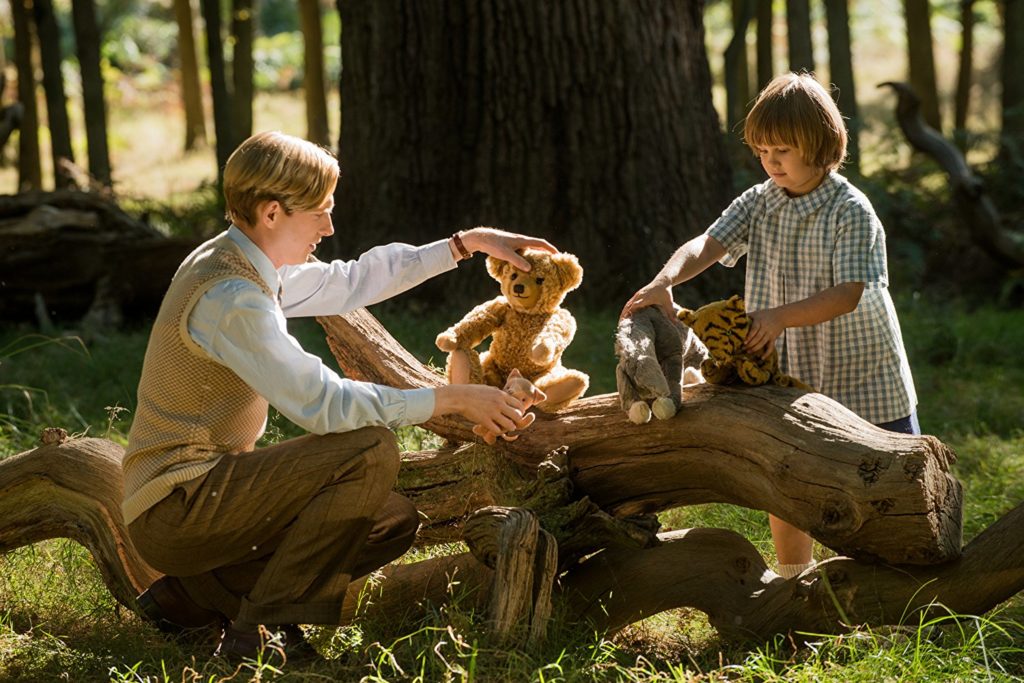
This is THE performance that will have everyone stand up and take notice of Domhnall Gleeson. An emotional transformation as well as being controlled methodical performance, the joy that Gleeson brings to A.A. Milne when he starts to engage and play with his son Christopher Robin is infectious. Countering that, the almost angry stoicism and PTSD within A.A. that we see for much of the film once WWI is over and the Milnes move to the country, is at times even frightening thanks to Gleeson’s intensity and the “closed-offedness” that he imbues within Milne. An extremely intricate and nuanced emotional performance.
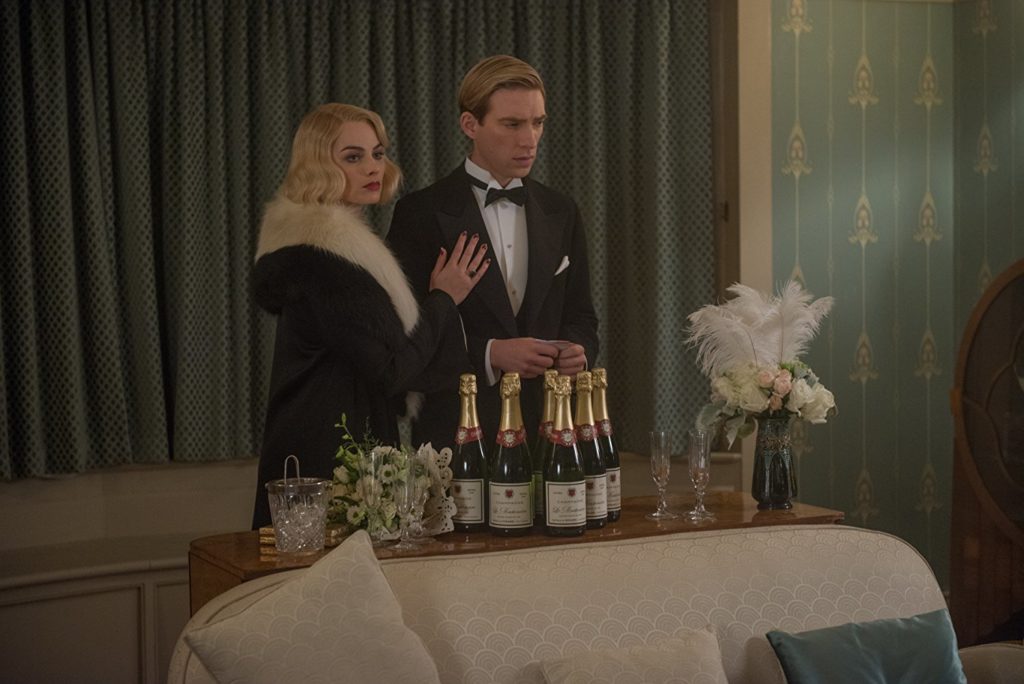
But the real scene stealer – and heart stealer – is Will Tilston as the 8-year old boy who goes on all these wonderful adventures with Pooh, Tigger, Kanga, Roo, Owl, Rabbit, and of course, Eeyore. He is pure enchantment on screen. So endearing, so believable, it’s as if the audience is osmotically embodying his little body engaging in all of these wonderful adventures with him and his friends. We believe and see as he does. If the Academy would start to recognize young performers as the Emmys do, Tilston (along with Jacob Tremblay), would be at the top of my list. And to watch him with Gleeson as a genuine father-son relationship develops is pure magic. Once Mummy and Nanny leave the house for a few days and the two men are left to their own devices, as Gleeson’s Milne opens up, we see the little boy in him take shape as he is swept into the imagination of Christopher Robin where the origination of the stories now begins.
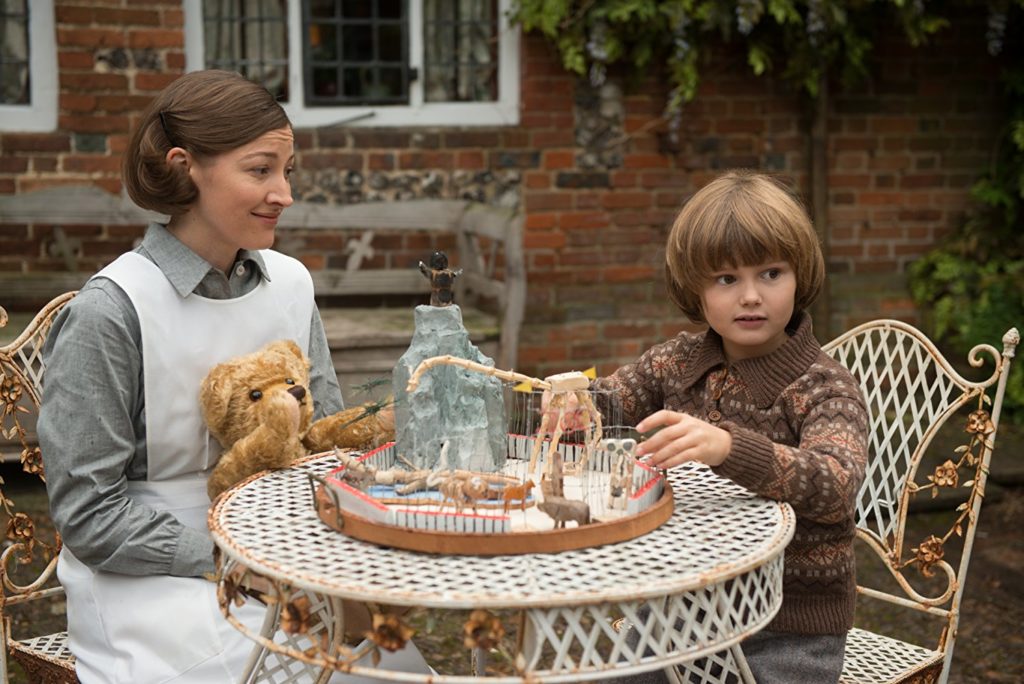
Stephen Campbell Moore brings his own wide-eyed wonder to Milne’s best friend and collaborator Ernest and his illustrations of Pooh and company. His facial expressiveness lights up with each new “find” or adventure, just like a kid on Christmas morning.
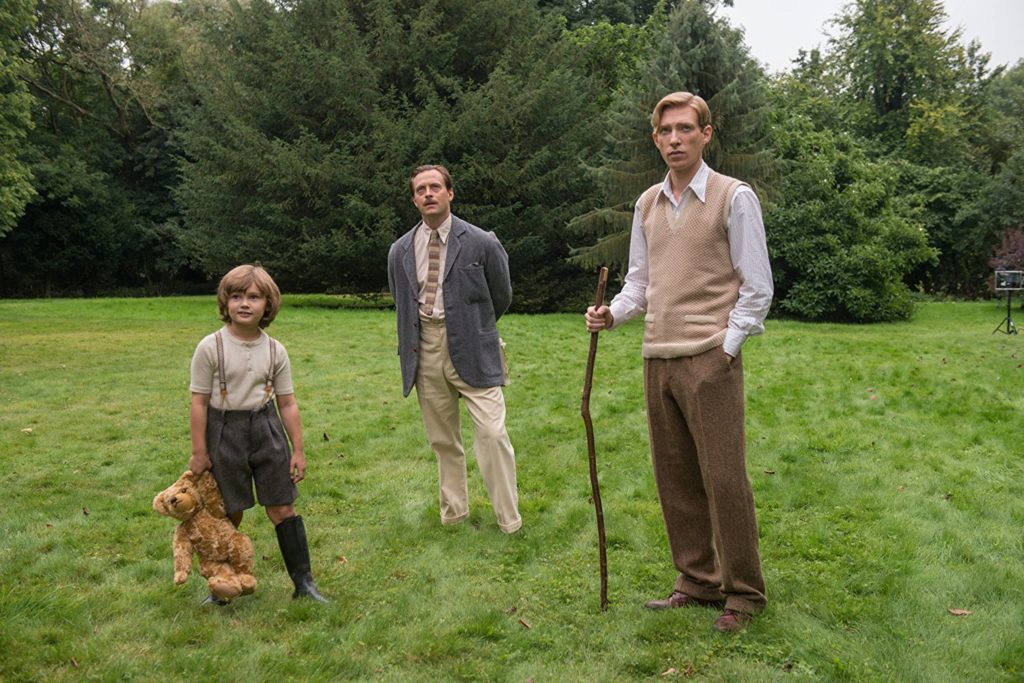
Matching the heart of Will Tilston’s Christopher Robin is Kelly Macdonald’s Olive, Christopher Robin’s nanny. Their chemistry is pure magic as love fills the screen and the heart watching the two of them. Margot Robbie is a glamorous annoyance, which is exactly what Daphne Milne was rumored to be.

Alex Lawther does a more than respectable job as 18-year old Christopher Robin going off to war. Lawther mirrors much of the defiance, stoicism, and closed-offedness we see Gleeson bring to A.A. Milne earlier in the film, lending itself to the strained father-son dynamic.
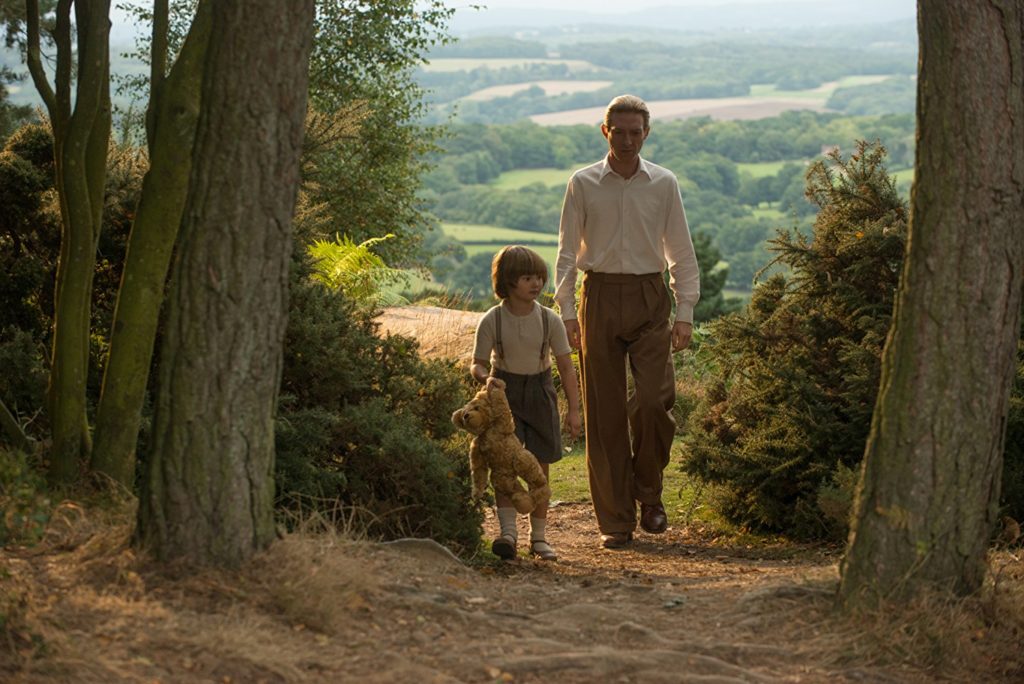
Ben Smithard’s cinematography is beautifully designed and executed. There is a softness to it that is welcoming. From the claustrophobic narrow staircases in the Milne country home to the wide angle expansiveness of the world of Pooh and the Hundred Acre Woods on the Milne grounds, we are immersed in each moment; moments captured through the POV of a little boy, his father, and a bear. But then Smithard also visually brings father and son to a level playing field in later years as now Private C.R. Milne goes off to war in WWII. Lighting sets the visual tonal bandwidth as Smithard cools the imagery when focusing on the early days of Daphne and A.A. Milne and Daphne’s carefree opulence, as well as scenes with the couple riding high on the success of the Pooh books. Contrasting that is the warmer golden tone of A.A. Milne’s writing study and Christopher Robin’s bedroom. Shadows within the Milne home metaphorically speak to A.A. Milne’s ongoing issues with PTSD. Streams of sunlight play into the canvas. But then as Christopher Robin’s world and that of Pooh take hold, lensing is light, bright, warmed by the sun and the true greens and blues of nature. Even costuming falls in with the visual tone as we see Christopher Robin, Pooh, and A.A. Milne all wearing tones that seem to almost make them a part of nature and the Hundred Acre Woods.
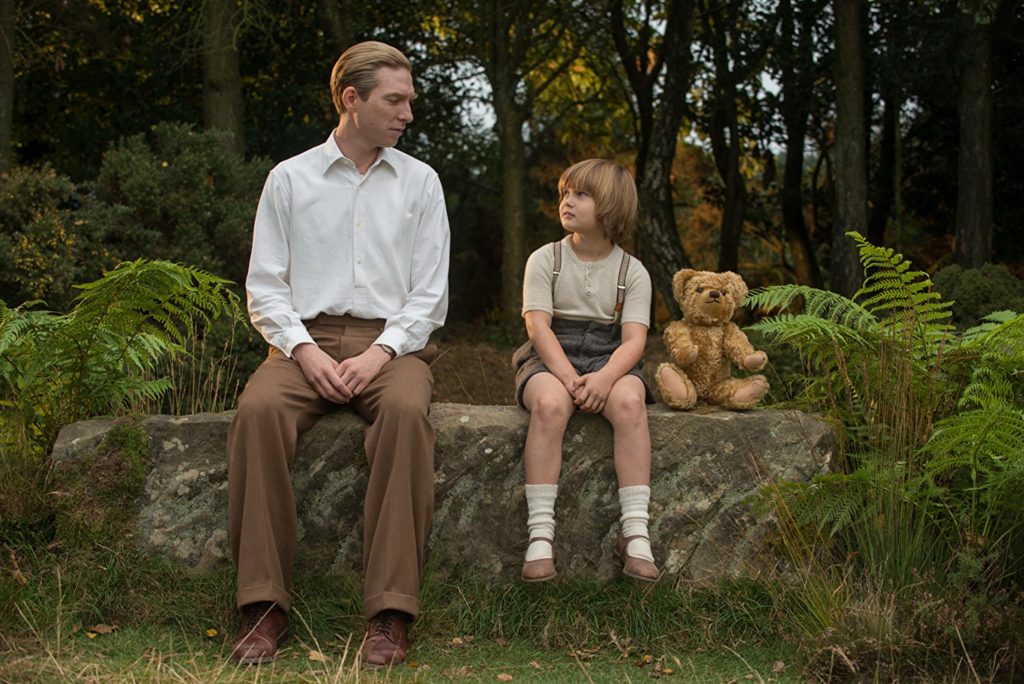
One of the keys to the film is the use of color and the visual simplicity of much of the film. Things like Rabbit’s blue door, and Pooh’s red balloon which he lost on a blustery day, are front and center at key moments in the story and are immediate touchstones for the world. Significant also are the shooting locations as Curtis takes us to the places the world knows so well from the books. We are on the actual bridge where Christopher Robin played “Pooh Sticks”. While the Milne country home on screen is not the actual home (although it is still standing and lived in, albeit remodeled), a neighboring home still with the original architectural configuration inside and out was used. The rock where father and son sit and contemplate the world of Winnie the Pooh and where Christopher Robin often sits with Pooh in the books is the actual rock. The combined result of these elements is a timelessness to the film as a whole.

David Roger’s production design is exquisitely done, capturing not only the beauty of the period but the decades and events of the time, notably distinguishing class. Hand-in-hand with Roger’s work is the costuming of Odile Dicks-Mireaux who continually wows with her intuitively beautiful work.
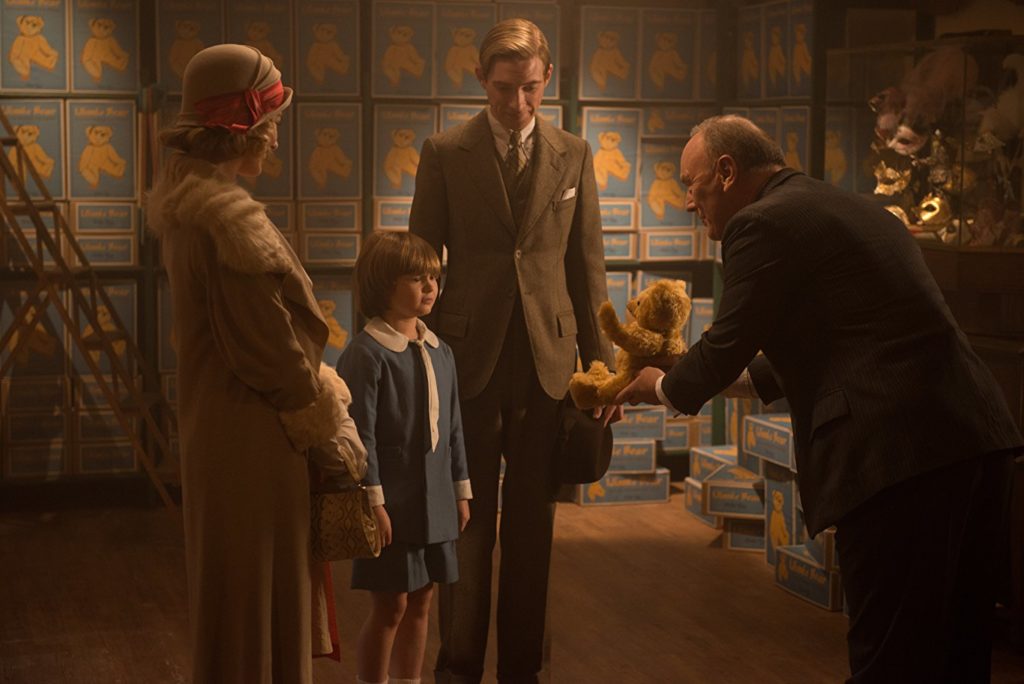
Especially appreciative is not only the overall production design and the cinematographic framing of the film with more intimate two-shots, but the editing. With a keen sense of pacing, editor Victoria Boydell taps into the frenzy that surrounded the Pooh books and Christopher Robin, allowing the audience to understand why the boy wanted to distance himself from the phenomena. On the flip side, Boydell takes us on a more leisurely pace as father and son explore the world of Pooh in their own backyard. A wonderful balance that speaks to the emotional notes of each character and, in the case of Christopher Robin, what shapes him for the future. Thanks in large part to the pacing of the film, we also keenly understand why Christopher Robin resented his father and mother by taking Pooh public, only to then reconsider once he himself was on the frontlines of battle during the war. As we see through Christopher Robin’s perspective, Pooh saved a generation from total emotional annihilation.
Carter Burwell’s score is exquisite as he not only creates a sweeping sense of the magnitude of the world of Pooh but the intimacy and whimsy of a boy and his dad and a bear. Some lovely musical themes running throughout the film.
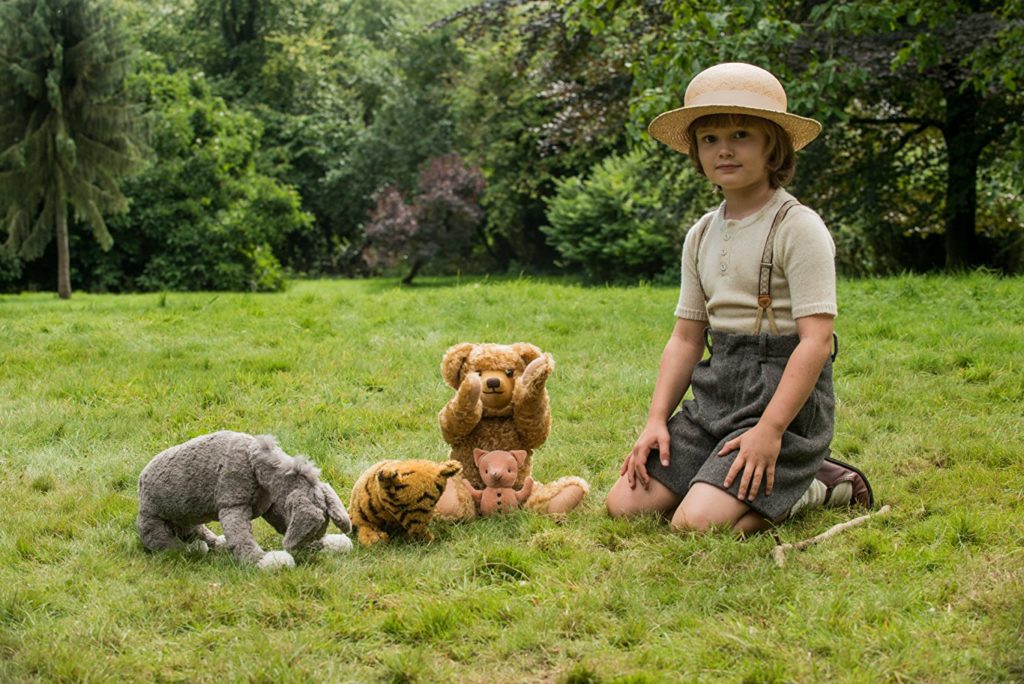
This is the stuff of which tears, tissues, and awards are made . . . and willy nilly silly old bears.
Directed by Simon Curtis.
Written by Frank Cottrell Boyce and Simon Vaughan
Cast: Domhnall Gleeson, Kelly Macdonald, Margot Robbie, Will Tilston, Stephen Campbell Moore, and Alex Lawther
by debbie elias, 10/06/2017












